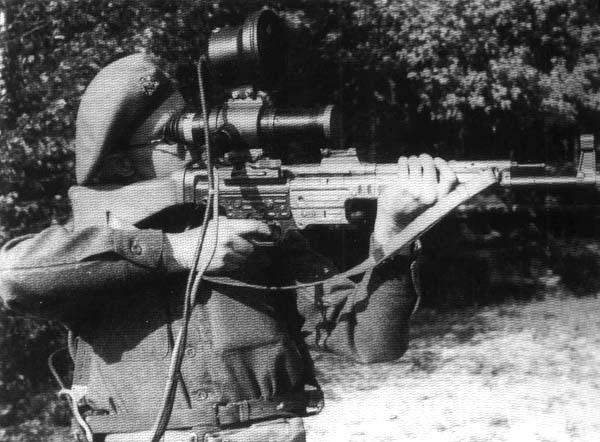
The History of Night Vision Optics: From Battlefield Innovation to Everyday Technology
Discover the history of night vision optics—from WWII origins to modern digital and thermal systems.
Night Vision: Seeing in the Dark
For centuries, the ability to see clearly in the dark has represented both a tactical advantage and a technological challenge. From the early days of World War II to the compact digital monoculars of today, night vision optics have evolved from classified military assets into tools for law enforcement, wildlife observation, and even recreational hunting.
This article traces the fascinating history of night vision optics, exploring how advances in electronics, imaging sensors, and infrared technology have shaped their development — and what the future holds for these devices.
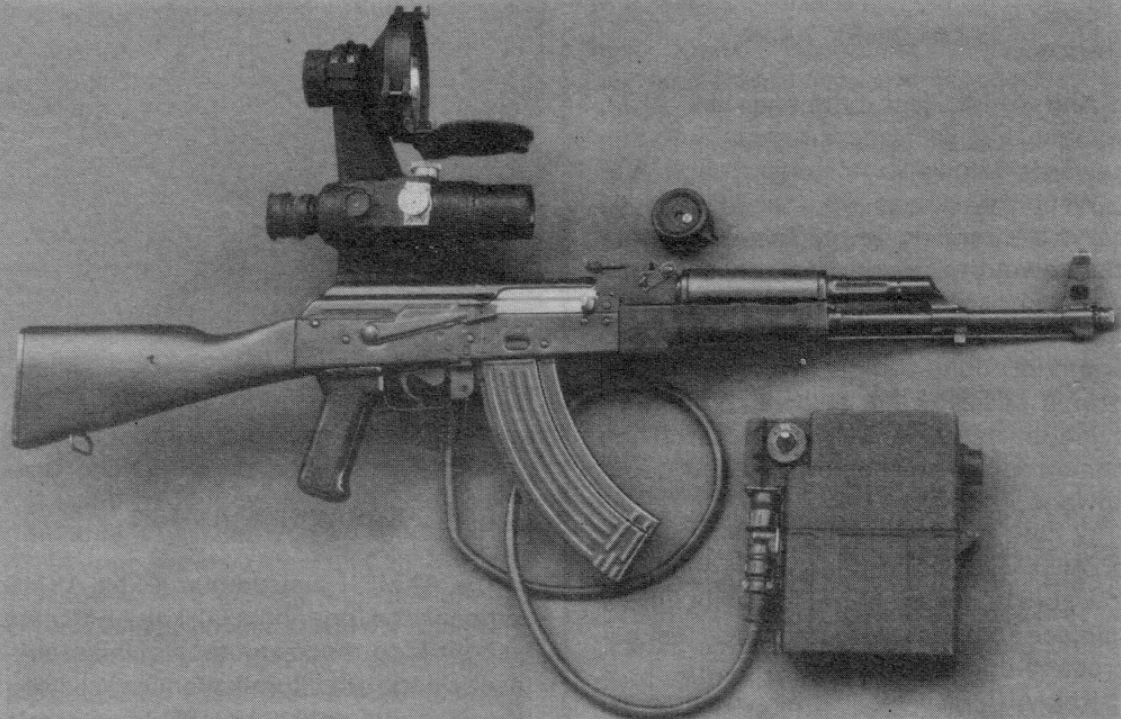 (NSP-2 Night Vision Scope)
(NSP-2 Night Vision Scope)
Early Origins: The World War II Era (1939–1945)
The Birth of Infrared Vision
Night vision technology first appeared during World War II, developed primarily by Germany and the United States. These early systems relied on active infrared (IR) illumination — invisible to the naked eye but visible through special optics that detected reflected IR light.
-
Germany’s Zielgerät 1229 “Vampir”: Introduced in 1944, was one of the first portable night vision scopes, designed for the StG 44 assault rifle. It used an infrared searchlight and a cathode-ray tube viewer to display illuminated images.
-
U.S. M1 and M3 Sniperscopes: The American counterpart, developed by the U.S. Army’s Signal Corps, operated on a similar principle and was deployed in the Pacific Theater during 1945.
These early devices were large, heavy, and power-hungry, relying on bulky batteries and limited in range to about 70–100 meters. However, they proved the concept — night operations were no longer confined to moonlight.
For an excellent technical overview of early infrared systems, visit the U.S. Army’s Night Vision and Electronic Sensors Directorate (NVESD).
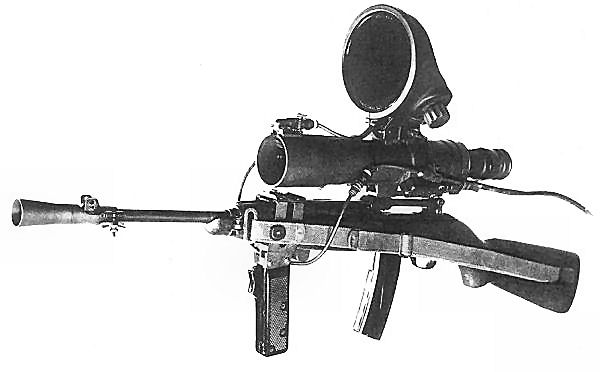 (M3 Infrared Sniper Rifle)
(M3 Infrared Sniper Rifle)
The Cold War and the Rise of Image Intensifiers (1950s–1970s)
Generation 1: Passive Night Vision
Following World War II, the Cold War drove rapid innovation in optics and sensor technologies. By the 1950s, the U.S. military shifted from active IR systems to passive image intensification, giving rise to what’s now called Generation 1 (Gen 1) night vision.
Rather than emitting IR light, Gen 1 devices amplified ambient light — such as starlight or moonlight — using a photocathode to convert photons into electrons, which were then accelerated and converted back into visible images.
Key Milestones:
-
1950s: Introduction of first image intensifier tubes.
-
1960s: U.S. Army adopts Gen 1 Starlight Scopes (AN/PVS-2).
-
Vietnam War: Night vision becomes a standard tactical advantage, especially for snipers and reconnaissance units.
Although Gen 1 optics suffered from edge distortion and required at least some natural light, they marked a quantum leap in night combat capabilities.
Expert Insight:
“The first generation of image intensifiers changed night warfare forever. For the first time, soldiers could see clearly without revealing their position,”
— Dr. Alan Roberts, Optical Systems Historian, Defense Tech Journal
For more on how image intensification revolutionized military optics, see the Defense Technical Information Center (DTIC) archives.
 (Examples of Gen 1-4 Image Quality)
(Examples of Gen 1-4 Image Quality)
The Leap to Generation 2: The 1970s–1980s Revolution
By the 1970s, researchers had improved intensifier technology with microchannel plates (MCPs) — a breakthrough that led to Generation 2 (Gen 2) optics. MCPs drastically boosted the electron amplification process, resulting in brighter, clearer images even in near-total darkness.
Notable Improvements:
-
Increased sensitivity and clarity.
-
Extended range and reduced blooming from bright light sources.
-
Miniaturization for handheld and head-mounted designs.
The U.S. AN/PVS-5 goggles, used extensively by pilots and ground troops, epitomized this era. Their success in operations like Desert Storm in the early '90s demonstrated how crucial night vision had become to modern military dominance.
Quote:
“The MCP changed everything. It made night vision practical for real-time use in dynamic environments,”
— Dr. Naomi Keller, Senior Engineer, Photonis Technologies
Learn more about MCP advancements in the Photonis Night Vision White Paper, a leading source for optical engineering insights.
Digital and Thermal Innovations: Generation 3 and Beyond (1990s–Present)
Generation 3: Gallium Arsenide Breakthrough
The 1990s saw another leap forward with Generation 3 (Gen 3) devices. These employed gallium arsenide (GaAs) photocathodes, delivering exceptional light sensitivity and resolution.
Advantages of Gen 3:
-
Excellent low-light performance.
-
Extended operational lifespan.
-
High image quality even in low ambient light.
Manufacturers such as ITT Exelis and L3Harris Technologies helped standardize Gen 3 for both military and civilian use, making them the global benchmark for night vision quality.
You can read about L3Harris’s contributions to this technology at L3Harris Night Vision.
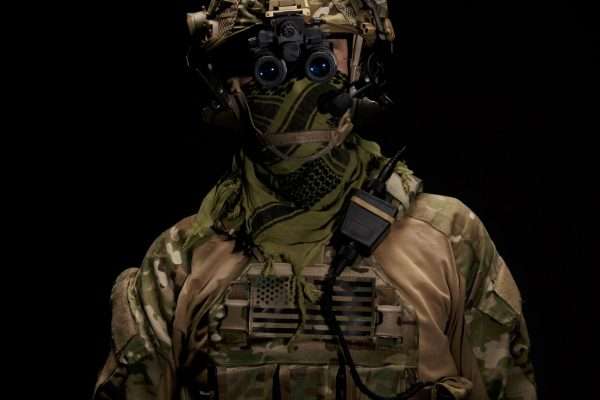 (Gen 3 Night Vision Goggles)
(Gen 3 Night Vision Goggles)
Thermal Imaging: A Parallel Revolution
While traditional night vision amplifies visible and near-infrared light, thermal optics detect heat signatures emitted by objects. This technology, originally developed for missile tracking in the 1950s, became commercially viable in the 1990s thanks to advances in uncooled microbolometer sensors.
An uncooled microbolometer is a type of thermal infrared sensor that detects heat without needing a cooling system. It consists of an array of tiny, temperature-sensitive resistors that change electrical resistance when they absorb infrared (IR) radiation, This resistance change is then converted into an electrical signal and used to create a thermal image. The previous generation of cooled microbolometer sensors were bulkier and more costly to produce making this new advancement perfect for commercial use.
Thermal imaging advantages:
-
Works in total darkness or smoke.
-
Detects living targets by heat contrast.
-
Increasingly affordable for civilian applications.
Today, thermal scopes and hybrid digital optics dominate the market, blending digital sensors, onboard processors, and wireless connectivity.
To learn about the physics behind thermal detection, visit FLIR Systems’ Knowledge Center — a comprehensive resource on infrared imaging technology and more.
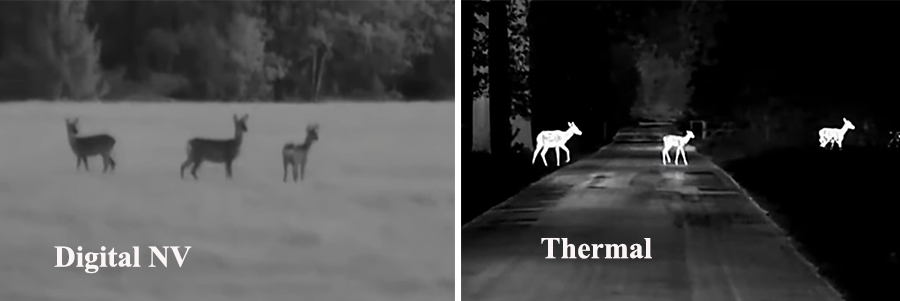 (Digital Night Vision vs Thermal)
(Digital Night Vision vs Thermal)
Digital Night Vision: The Modern Era
In the 21st century, digital technology has redefined night vision. Modern devices use CMOS and CCD sensors — similar to those in cameras — to digitally enhance and display low-light imagery.
These digital night vision scopes often include features like:
-
HD video recording and Wi-Fi streaming.
-
Adjustable IR illuminators.
-
GPS and rangefinding integration.
-
Compatibility with smartphones and tablets.
Brands such as Pulsar, ATN, and Trijicon now make advanced optics accessible to civilians, hunters, and outdoor enthusiasts — democratizing what was once restricted to military use.
 (Night Vision Hunter in Ghillie Suit)
(Night Vision Hunter in Ghillie Suit)
Applications Beyond Combat
Night vision optics have expanded far beyond the battlefield:
-
Law Enforcement: Surveillance, search, and rescue.
-
Wildlife Observation: Studying nocturnal behavior without disturbance.
-
Recreational Use: Hunting, hiking, and night photography.
-
Industrial and Marine: Security and navigation in low-light conditions.
For a broader look at civilian and conservation uses, refer to National Geographic’s Night Vision Features which explores wildlife research applications.

(Recreational Use of Night Vision Binoculars
The Future of Night Vision Optics
As AI-enhanced imaging, fusion technology, and nanophotonic materials emerge, the next generation of night vision promises even greater capability. Researchers are developing “fusion optics” that combine image intensification with thermal imaging into a single, seamless display — giving users unparalleled clarity and situational awareness.
Future trends include:
-
AI object recognition for threat detection.
-
Augmented reality (AR) overlays for tactical data.
-
Graphene-based photocathodes for ultra-high sensitivity.
“Night vision will soon integrate with augmented reality systems, merging digital data with real-time low-light imaging,”
— Lt. Col. Brandon Weiss (Ret.), Defense Innovation Analyst, VisionTech Labs
Timeline Summary: Key Milestones in Night Vision History
| Year | Generation | Key Innovation | Primary Use |
|---|---|---|---|
| 1940s | Prototype / Gen 0 | Active infrared systems (Vampir, Sniperscope) | Military |
| 1960s | Gen 1 | Passive starlight scopes | Vietnam War |
| 1970s | Gen 2 | Microchannel plate intensifiers | Modern warfare |
| 1990s | Gen 3 | GaAs photocathode, improved clarity | Tactical & law enforcement |
| 2000s+ | Digital & Thermal | CMOS sensors, thermal fusion | Civilian, industrial, military |
Understanding Night Vision
What’s the difference between night vision and thermal imaging?
Night vision amplifies existing light, while thermal imaging detects heat. Thermal devices work in complete darkness but lack the detailed texture that night vision provides.
Can civilians legally own night vision devices?
Yes, in most countries. However, export restrictions apply for high-spec Gen 3 or military-grade optics under ITAR regulations.
What is the best generation for general use?
For most enthusiasts, digital night vision offers the best balance between affordability, performance, and versatility. However, thermal imaging is most popular among hunters.
Night Vision: From Shadows to Clarity
The evolution of night vision optics reflects the broader story of human innovation — transforming darkness from a barrier into an opportunity. From the crude infrared scopes of World War II to AI-enhanced digital fusion systems, each generation has expanded our ability to see the unseen.
For enthusiasts, professionals, and innovators alike, the history of night vision is more than a tale of technology — it’s a testament to the enduring pursuit of clarity, even in the darkest conditions.
To see more options for night vision devices, check out our website:
-
“Explore our array of night vision scopes" — for readers seeking hands-on examples of modern technology.
